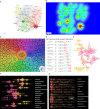Trends in metabolic dysfunction in polycystic ovary syndrome: a bibliometric analysis
- PMID: 37701893
- PMCID: PMC10494444
- DOI: 10.3389/fendo.2023.1245719
Trends in metabolic dysfunction in polycystic ovary syndrome: a bibliometric analysis
Abstract
Polycystic ovary syndrome (PCOS) is a very common chronic disease and causes reproductive disorders in women of childbearing age worldwide. The cause of metabolic dysfunction in PCOS is unknown, and there is a lack of systematic bibliometric analysis for this disease. This study included 3,972 articles on metabolic dysfunction in PCOS published from 2012 to 2021. We applied the VOSviewer and the CiteSpace scientometric analysis software to analyze the data regarding the publication of the articles, countries, authors, institutions, scientific categories, cited journals, and keywords. Through this analysis, we determined the research efforts and their developing trends and anticipated the progress in understanding PCOS-related metabolic dysfunction.
Keywords: CiteSpace; VOSviewer; bibliometric analysis; metabolism; polycystic ovary syndrome.
Copyright © 2023 Xu, Cao, Chen and Ren.
Conflict of interest statement
The authors declare that the research was conducted in the absence of any commercial or financial relationships that could be construed as a potential conflict of interest.
Figures





Similar articles
-
The relationship between polycystic ovary syndrome and coronary heart disease: a bibliometric analysis.Front Endocrinol (Lausanne). 2023 May 8;14:1172750. doi: 10.3389/fendo.2023.1172750. eCollection 2023. Front Endocrinol (Lausanne). 2023. PMID: 37223024 Free PMC article. Review.
-
Research hotspots of polycystic ovary syndrome and hyperandrogenism from 2008 to 2022: bibliometric analysis.Gynecol Endocrinol. 2024 Mar 2;40(1):2326102. doi: 10.1080/09513590.2024.2326102. Epub 2024 Apr 24. Gynecol Endocrinol. 2024. PMID: 38654639 Review.
-
The relationship between polycystic ovary syndrome and insulin resistance from 1983 to 2022: A bibliometric analysis.Front Public Health. 2022 Jul 28;10:960965. doi: 10.3389/fpubh.2022.960965. eCollection 2022. Front Public Health. 2022. PMID: 35968428 Free PMC article. Review.
-
Research on polycystic ovary syndrome: a bibliometric analysis from 2009 to 2019.Gynecol Endocrinol. 2021 Feb;37(2):121-125. doi: 10.1080/09513590.2020.1807501. Epub 2020 Aug 19. Gynecol Endocrinol. 2021. PMID: 32812809
-
Bibliometric analysis of the research on anti-Müllerian hormone and polycystic ovary syndrome: current status, hotspots, and trends.Front Reprod Health. 2025 Apr 24;7:1519249. doi: 10.3389/frph.2025.1519249. eCollection 2025. Front Reprod Health. 2025. PMID: 40342310 Free PMC article.
Cited by
-
Bibliometric analysis of research in epilepsy and comorbid depression from 2014 to 2023.World J Psychiatry. 2024 Jun 19;14(6):985-998. doi: 10.5498/wjp.v14.i6.985. eCollection 2024 Jun 19. World J Psychiatry. 2024. PMID: 38984335 Free PMC article.
-
A bibliometric analysis of domestic and international research on hemorrhagic fever with renal syndrome over the past 2 decades.Medicine (Baltimore). 2024 Sep 13;103(37):e39737. doi: 10.1097/MD.0000000000039737. Medicine (Baltimore). 2024. PMID: 39287241 Free PMC article.
-
Frontotemporal lobar degeneration and amyotrophic lateral sclerosis: A bibliometric analysis.Medicine (Baltimore). 2025 Jul 4;104(27):e43180. doi: 10.1097/MD.0000000000043180. Medicine (Baltimore). 2025. PMID: 40629595 Free PMC article.
-
Assessing the impact of PCSK9 and HMGCR inhibitor on reproductive endocrine diseases: A drug-target Mendelian randomization analysis.Medicine (Baltimore). 2025 May 30;104(22):e42685. doi: 10.1097/MD.0000000000042685. Medicine (Baltimore). 2025. PMID: 40441203 Free PMC article.
-
Global trends and research hotspots in autophagy and tumor drug resistance: a bibliometric analysis.Discov Oncol. 2025 May 12;16(1):734. doi: 10.1007/s12672-025-02379-5. Discov Oncol. 2025. PMID: 40354002 Free PMC article.
References
Publication types
MeSH terms
LinkOut - more resources
Full Text Sources
Medical

